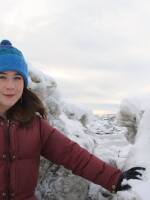As spring sets in and the school year draws to a close, students from the village of Igiugig pitch their tents across the Kvichak River for Goose Camp.
In southwest Alaska spring brings geese, and in Igiugig geese bring Goose Camp. It’s a three-day culture camp for the Yupik community that lives on the south side of Iliamna Lake at the mouth of the Kvichak River. Across the river from town, a now defunct lodge sits on top of a hill. The owners of the land allow goose camp to use the site. In return, the students clean up a portion of the grounds each year.
May sunlight shines bright on the second day of camp. Igiugig’s elementary schoolers sit in a circle, crushing brittle red rocks between two larger stones. At the center of the circle, archeologist Monty Rogers explains that this is the way people in the area made paint for thousands of years.
“I’d probably go with the oral histories in that folks have been here longer than 8000 years. That whole time people have been wanting to paint. What do you think they made paints out of?” Rodgers asks.
The kids float their ideas—rocks, berries, and clay.

The painting lesson is a highlight for Igiugig’s youngest set. Rogers leads the kids to a map pinned to the side of one of the old buildings. Colored arrows point to places with Yup’ik and Dena’ina place names. One student notices that a site where his ancestors could have collected red paint rocks sits just down river from Igiugig.
After they discuss where their ancestors could have collected pigment, each child receives a strip of birch bark. They add water to the red powder they have crushed and use twigs they collect as brushes.
“I drew a man, and he got hit, and he’s fat,” says eight-year-old Jonathan Alvarez, explaining drawing. The painted stick figure appears to have an arrow sticking from his side. Alvarez holds the bark still as he draws so that the watery paint will not run.
When the elementary schoolers are done painting, Rogers devotes the afternoon to teaching the middle and high schoolers to make traditional slate knives with driftwood handles.

Goose Camp is in its fourth year. The initiative started with instructors at Igiugig’s small school.
“I wanted to start something that was culturally responsive and based on the geese that explode down here in the spring,” says head teacher Tate Gooden. “We have the little kids watching the big kids, and everybody is watching the elders, sharing jobs and stories. One of our hopes is that this is kind of a leadership camp.”
The loose theme this year is Yup’ik language, arts, and crafts. For the language portion, the students gather around the campfire for a quick Yup’ik lesson. AlexAnna Salmon stands at the head of the group. She oversees the village’s revitalization program and has been teaching the school kids for a couple of years. Students repeat after her as they review the words and phrases they know.

The vision of goose camp is to give students a chance to practice skills people around Iliamna Lake have used for centuries, skills that are still useful in Igiugig today. Salmon explains that goose camp is more than a getaway or a time to learn to paint and practice Yup’ik.
“In the Western worldview, you own a place. ‘I’m here. This place is named after me, and I own it,’” says Salmon. “For the Yupik way, it’s, ‘You belong there. That’s the place of land where you belong.’ And the very word for happiness stems from that. When you’re happy, you know you’re in the right place, and you’re content.”
The campers seem happy as they wrap up Goose Camp with yuraq, which means Yupik dance. Two drummers keep time and lead the singing.
"Wangkuta Yurartenguukut Nasviiciqamteggen Makuryat Yuraatnek," says Kiara Nelson, introducing one the village favorites.
Middle schooler, Kaylee Hill translates, "This is song about all of the mosquitos in Igiugig and how we constantly try to smack them."
Dancers swat imaginary mosquitos around their faces as they sing along in Yup’ik about the place to which they belong.
Contact the author at avery@kdlg.org or 907-842-2200.







